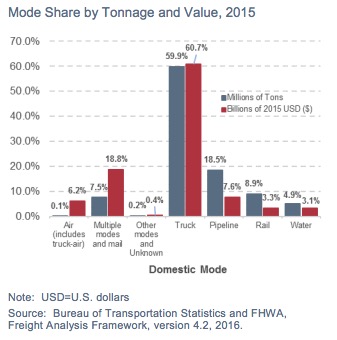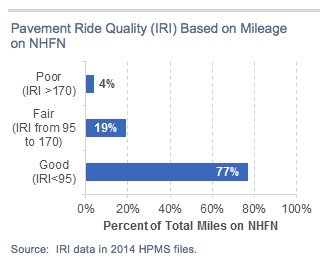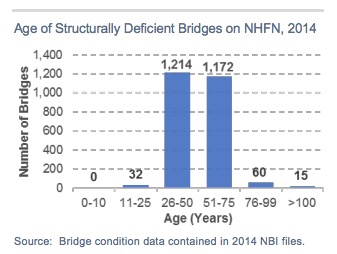UNITED STATES DEPARTMENT OF TRANSPORTATION
Status of the Nation’s Highways, Bridges and Transit: 23rd Edition: Conditions and Performance, 23rd Edition
Par III: Highway Freight Transportation
Chapter 11: Freight Transportation
 Freight transportation is vital to the U.S. economy and the daily needs of Americans throughout the country. Households and businesses depend on the efficient and reliable delivery of freight to both urban and rural areas. Federal support for freight increased under the Fixing America’s Surface Transportation (FAST) Act, as the FAST Act included provisions to define, establish, and provide funding for a national highway freight program. The FAST Act freight provisions were designed to address significant needs in the transportation system to ensure that projected increases in freight volumes can be handled efficiently across all transportation modes.
Freight transportation is vital to the U.S. economy and the daily needs of Americans throughout the country. Households and businesses depend on the efficient and reliable delivery of freight to both urban and rural areas. Federal support for freight increased under the Fixing America’s Surface Transportation (FAST) Act, as the FAST Act included provisions to define, establish, and provide funding for a national highway freight program. The FAST Act freight provisions were designed to address significant needs in the transportation system to ensure that projected increases in freight volumes can be handled efficiently across all transportation modes.
In 2015, the transportation system handled a record amount of freight—including a daily average of approximately 55 million tons of freight, worth approximately $49.5 billion. The freight transportation industry employed 4.6 million workers and contributed 9.5 percent of the Nation’s economic activity as measured by gross domestic product (GDP).
Although freight moves on all modes of transportation, trucks are involved in the movement of most goods. The highway system is the most-used mode of transport for freight by tonnage and value of goods moved. Commodities moved by truck have a higher value per weight, which gives trucking a higher share of freight dollar value.
Trucking accounted for nearly 30.5 percent of total transportation and warehousing sector employment. Truck driving is by far the largest freight transportation occupation, with approximately 2.83 million truck drivers. About 57.5 percent of these professional truck drivers operate heavy trucks and 28.2 percent drive light trucks.
As freight movements increase, the number of available safe truck parking spaces diminishes and is a growing concern.
Truck Parking
Truck drivers need safe, secure, and accessible truck parking. With the projected growth in truck traffic, demand for truck parking will continue to outpace supply. In 2014, FHWA worked with States and industry partners on the Jason’s Law Truck Parking Survey Results and Comparative Analysis to assess these needs. The resulting information quantified the commercial motor vehicle parking shortage at facilities along the National Highway System. The survey provided direct insight into parking issues: more than 75 percent of truck drivers surveyed said they regularly experienced problems finding “safe parking locations when rest was needed.”
Chapter 12: Conditions and Performance of the National Highway Freight Network
The Fixing America’s Surface Transportation (FAST) Act designated the National Highway Freight Network (NHFN) and established a national policy of maintaining and improving the conditions and performance of this new network. Furthermore, it required the development of a regular report on the conditions and performance of the NHFN. This chapter serves as the first of these reports.
Conditions

 In 2012, the NHFN consisted of 51,029 centerline miles, including 46,947 centerline miles of Interstate and 4,082 centerline miles of non-Interstate roads. Based on 2014 international roughness index (IRI) data from the Highway Performance Monitoring System (HPMS), approximately 77 percent of pavement miles were rated as having good ride quality, 19 percent had fair ride quality, and 4 percent had poor ride quality.
In 2012, the NHFN consisted of 51,029 centerline miles, including 46,947 centerline miles of Interstate and 4,082 centerline miles of non-Interstate roads. Based on 2014 international roughness index (IRI) data from the Highway Performance Monitoring System (HPMS), approximately 77 percent of pavement miles were rated as having good ride quality, 19 percent had fair ride quality, and 4 percent had poor ride quality.
The National Bridge Inventory is used to identify current bridge ratings for bridges on the NHFN. This analysis showed there are approximately 57,600 bridges on the NHFN. Around 4.3 percent of those bridges were rated as structurally deficient. Most of these structurally deficient bridges are 25 years and older, and over half are more than 50 years old. These findings have implications for future maintenance and funding needs as well as impacts to operations.
Performance
Travel time, speed, and safety are three measures of performance. Slower speeds and unreliable travel times caused by congestion increase fuel cost and affect operations and productivity, which adds expense to the freight transportation system. In 2014, congestion created stop-and-go conditions on 5,800 miles of the NHFN and caused traffic to travel below posted speed limits on an additional 4,500 miles of the high-volume truck portions of the NHFN. The projected growth in freight and its reliance on trucks will increase congestion and make it more difficult and costly to move freight.
A total of 3,633 fatal crashes occurred on the Interstate portion of the NHFN in 2014, resulting in 4,094 fatalities. In 2015, fatal crashes and fatalities increased by 5.7 percent and 6.1 percent, respectively.
Download full version (PDF): Highway Freight Transportation
About the United States Department of Transportation
www.transportation.gov
The mission of the Department is to ensure our nation has the safest, most efficient and modern transportation system in the world; that improves the quality of life for all American people and communities, from rural to urban, and increases the productivity and competitiveness of American workers and businesses.
Tags: Freight, Freight Infrastructure, Trucking, United States Department of Transportation, US DOT






 RSS Feed
RSS Feed